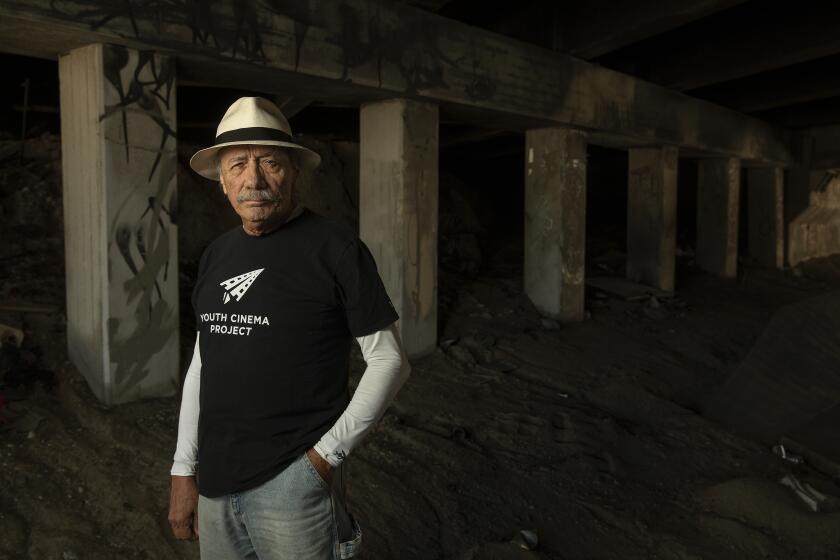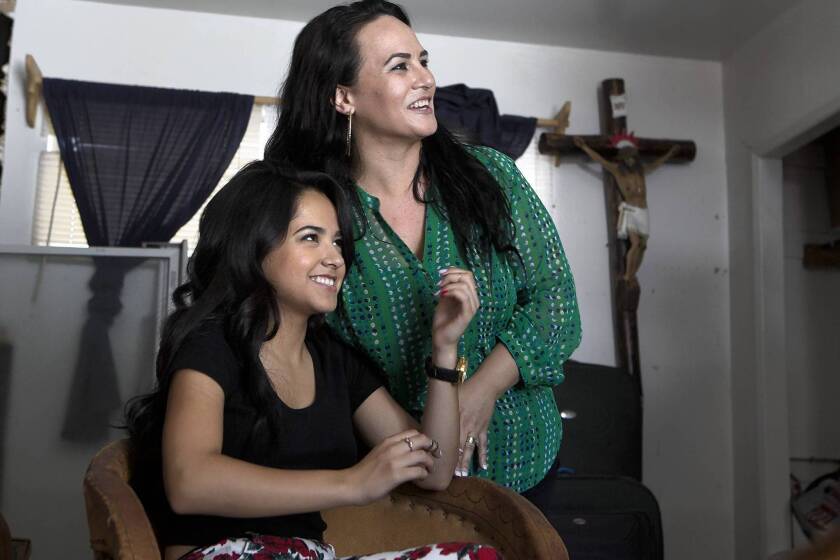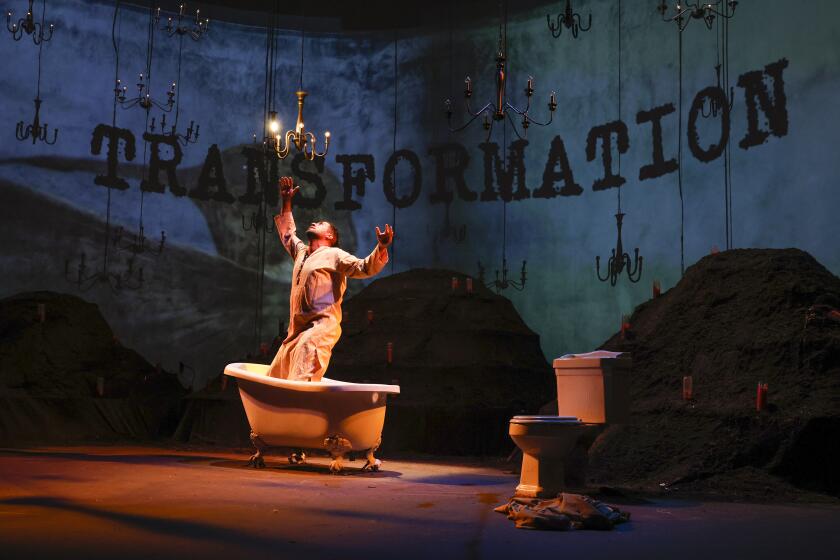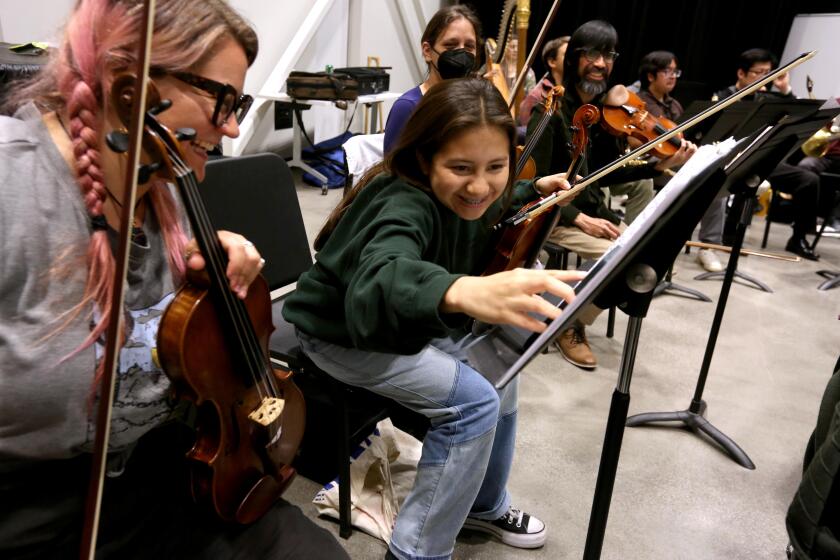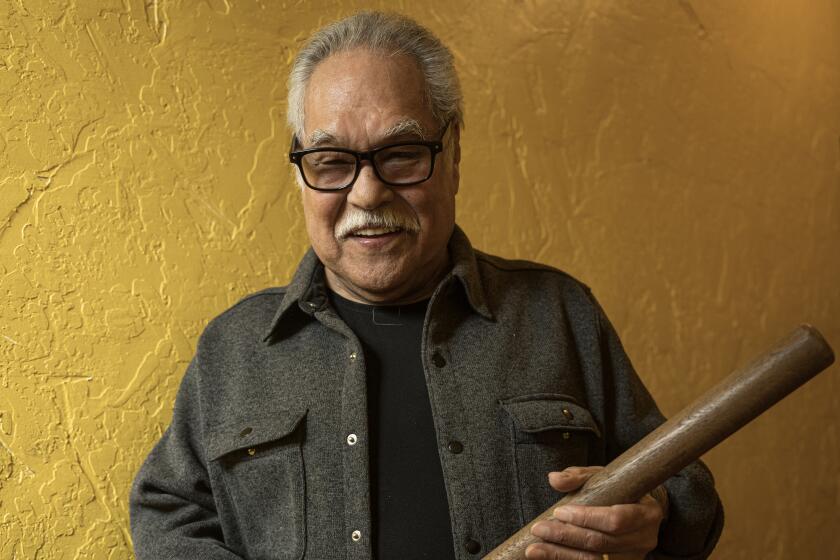Can L.A.’s Maria Rosario Jackson use art to heal an anxious America? Joe Biden thinks so
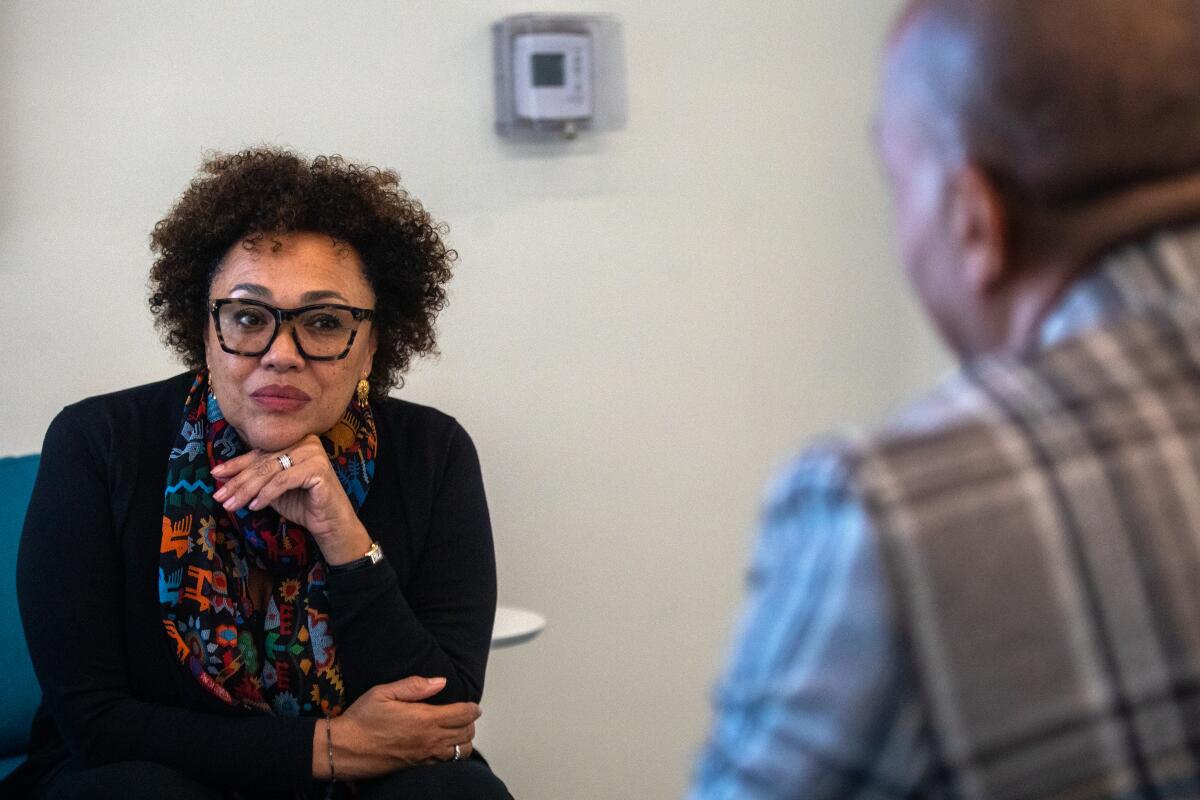
- Share via
In her young, impressionable years in L.A. and Mexico City, Maria Rosario Jackson had two cultural reckonings that shaped her outlook as the first Mexican American and African American woman to serve as the nation’s arts czar.
One was hearing a deceptively languid 1930s protest anthem that conjures up the ghastly image of “Black bodies swinging in the Southern breeze.” The other was seeing a frenetic mural depicting a dapper Mexican boy holding hands with a skeletal woman in white.
For the record:
11:15 a.m. Jan. 26, 2024An earlier version of this story incorrectly stated that the Pine Ridge Reservation is in Nebraska. It is in South Dakota.
Both experiences arose from Jackson’s bicultural birthright. Her father, an African American from Ohio by way of the Jim Crow South, introduced her as a child to Billie Holiday’s haunting anti-lynching ballad, “Strange Fruit.”
“I couldn’t get it, and he had to explain it to me,” said Jackson, a native of L.A.’s Crenshaw neighborhood who in January 2022 took office as President Joe Biden’s pick to chair the National Endowment for the Arts. “It is a beautiful song, but it is deeply meaningful and disturbing.”
The mural encounter sprang from regular visits with Jackson’s Mexican mother to Mexico City, where Diego Rivera’s monumental 1947 fresco painting “Sueño de una tarde dominical en la Alameda Central” (“Dream of a Sunday Afternoon in Alameda Park”), an uproarious hallucination of early 20th century Mexican society featuring notable historical figures, loomed on the wall of the Hotel del Prado.
“I would see that mural over and over and came to know it quite well,” Jackson recalled. “And there’s the dreamy part of it, there’s the macabre part of it, the political part of it.”
In Jackson’s intersectional credo, art speaks many languages and radiates many shades of meaning. It can inspire and heal, unsettle and provoke. It can break through ideological bunkers. Rather than an add-on luxury, it’s a fundamental building block of vibrant souls and just societies.
Now she just has to persuade the rest of the federal government to embrace that vision.
“Ultimately, it’s about people’s life journeys,” Jackson said over lunch at Mercado La Paloma in South L.A. one spring afternoon last year, speaking in the gently authoritative tone of a woman who seems born to be the Adult in the Room. “Those are complicated.”
The revered actor-director got an Oscar nomination for playing an East L.A. schoolteacher. Through the Latino Film Institute he’s fulfilling that role in real life by letting young people of color tell their stories on film.
Her career — or, more accurately, careers — spans philanthropy, government, a think tank and academia. It encompasses a nearly two-decade tenure at the Washington, D.C.–based think tank Urban Institute as founding director of the Culture, Creativity and Communities Program; an extended stay as senior advisor on arts, culture and strategic learning at the Detroit-based, deep-pocketed Kresge Foundation; and a tenured professorship at Arizona State University, where she led the Studio for Creativity, Place and Equitable Communities, and from which she’s currently on leave.
In Los Angeles, where she earned a bachelor’s in journalism from USC and a PhD in urban planning from UCLA and lives with her husband, David K. Riddick, Jackson has long been a recognized thought leader in arts and community development. In the mid-2010s, she co-chaired, with Tim Dang and Helen Hernandez, the L.A. County Arts Commission advisory committee that over 18 months of town halls and marathon meetings crafted recommendations that made diversity and inclusion a cornerstone of county arts policy.
“Maria was always able to create a sense of calmness for folks, especially dealing with some really challenging topics like equity and inclusion. She exudes this kind of confidence, but it’s this really quiet, subtle confidence,” said Leticia Rhi Buckley, chief executive of LA Plaza de Cultura y Artes in downtown L.A., who worked with Jackson on the county’s cultural initiative and credits her with drafting policies that gave the recommendations real teeth.
Column One: Rapping, songwriting, acting, modeling -- it’s all part of the ambitious Latina teen Becky G’s plans for superstardom, a goal she sings about in her debut, ‘Becky From the Block.’
In her current federal role, on any given day, Jackson might be strategizing with Health and Human Services Secretary Xavier Becerra or Transportation Secretary Pete Buttigieg about how artists and designers can, as she puts it, “help to imagine policy, help us understand how things are working, or not, and help imagine the communities we want to create.” She might be visiting the Pine Ridge Reservation in South Dakota to learn how Native Americans are reclaiming Indigenous languages, or jetting off to a poetry festival of African American female elders at Jackson State University, an HBCU in Mississippi, or meeting with Bruce Springsteen. (“It was awesome,” she said of her recent skull session with the Boss.)
In a capital packed with bloviators and arm-twisters, Jackson maintains an equipoise of soft-spoken graciousness, combining intellectual clarity with iron resolve.
“That’s what’s so magical about Maria’s tenure. She’s not sidestepping the hard questions. She’s reframing them in terms of what arts can do in the most distressed or marginalized or under-optimized places,” said Rip Rapson, chief executive of the Kresge Foundation, who has known Jackson for 15 years.
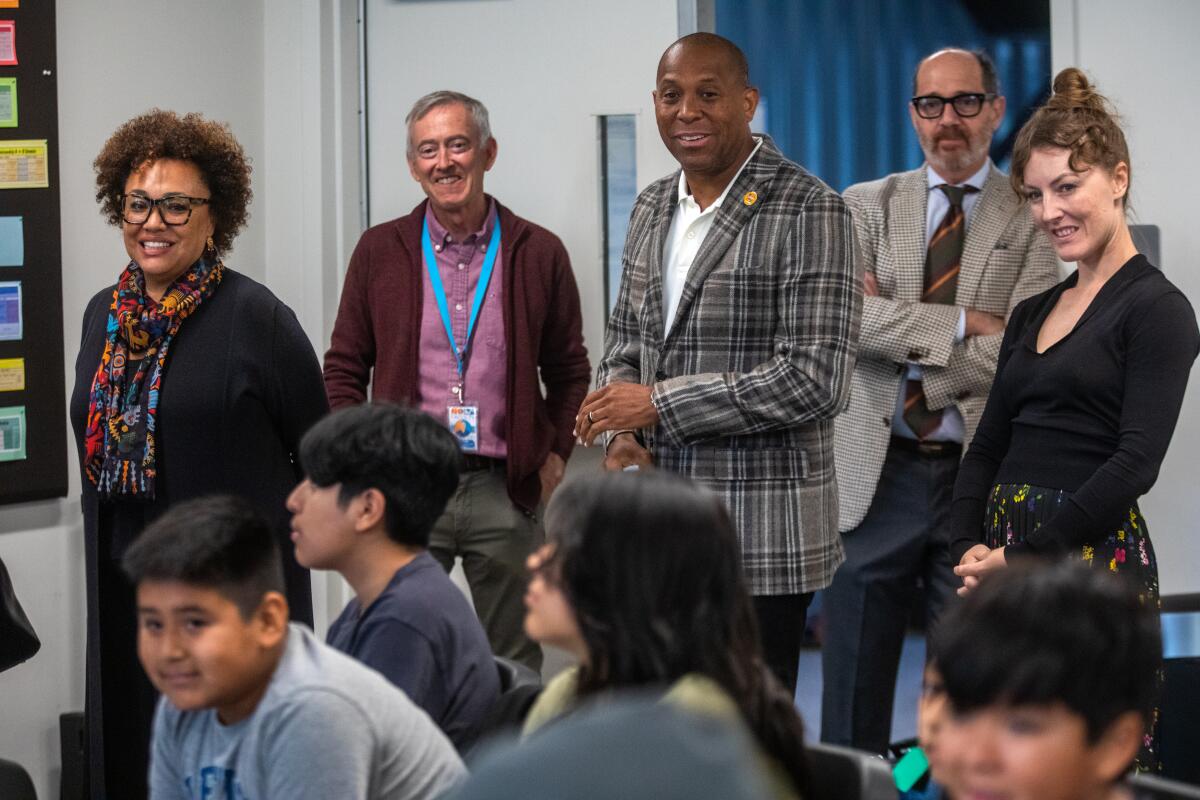
As the third year of Jackson’s appointment gets underway, her energies in Washington are focused on ArtsHere, a new NEA initiative to fund and promote greater arts participation in U.S. communities in areas like health/well-being and climate/environment; and a first-of-its-kind summit on Jan. 30, co-hosted by the NEA and the White House Domestic Policy Council, that will explore how the arts “can contribute to health and well-being, animate and strengthen physical spaces, fuel our democracy and drive equitable outcomes for communities across the country.”
In the latest work by the L.A. native and MacArthur ‘genius’ grant winner, a bleeding man’s arrival tests the faith of an order of Central Valley monks
But between frequent-flier engagements, Jackson stays connected to her hometown.
That same morning last spring, she and colleague Sonia Chala Tower met with staffers at Esperanza Community Housing Corp., a social justice nonprofit that sits in a former garment sweatshop east of USC and fosters community development within Black, Latino immigrant and Indigenous neighborhoods. Over the last three years, Esperanza has taken in more than $100,000 in NEA grants to support events like its Afro-Latinx Festival and projects like its South Central Archive, a multimedia timeline of community stories, photo portraits and other culturally revelatory keepsakes.
Zooming into the meeting, Nancy Halpern Ibrahim, Esperanza’s executive director and board president, told Jackson that NEA-backed projects like these reinforce community identity and act as a cultural buffer against the voracious market forces gobbling up the historically Afro-Latino neighborhood.
Wendy Navarro, a young Esperanza graphic designer, videographer and founder of Grit Media, who grew up in the neighborhood, chimed in that the NEA’s support has been crucial to Esperanza’s post-pandemic recovery.
“The arts were really important in creating these spaces for healing as we were coming out of COVID,” Navarro told Jackson, “because we were experiencing losses, losing loved ones, neighbors losing their jobs.”
Shortly after her session at Esperanza, Jackson headed over to Little Tokyo to meet with staff at East West Players, the nation’s longest-running Asian American theater. She wrapped up her day at HOLA — Heart of Los Angeles, a nonprofit on the edge of Lafayette Park whose stated mission isn’t to find the next Gustavo Dudamel but to give “underserved kids an equal chance to succeed through a comprehensive array of after-school academic, arts, athletics and wellness programs.”
It’s more than music. This Los Angeles orchestra bridges cultural and generational gaps and creates a deep sense of community
More than 98% of students who attend HOLA programs graduate high school, and more than 95% go on to higher education. The NEA’s annual $50,000 in funding — the most from any government source — has been crucial to meeting those goals, HOLA Chief Executive Tony Brown told Jackson.
“It isn’t just about giving someone access to the arts,” he said. “It’s about giving access to excellence through the arts. Without these types of resources that we receive from the NEA, I think we’d be less of a quality organization, more of a let’s-serve-as-many-kids-as-possible and just get ’em through.”
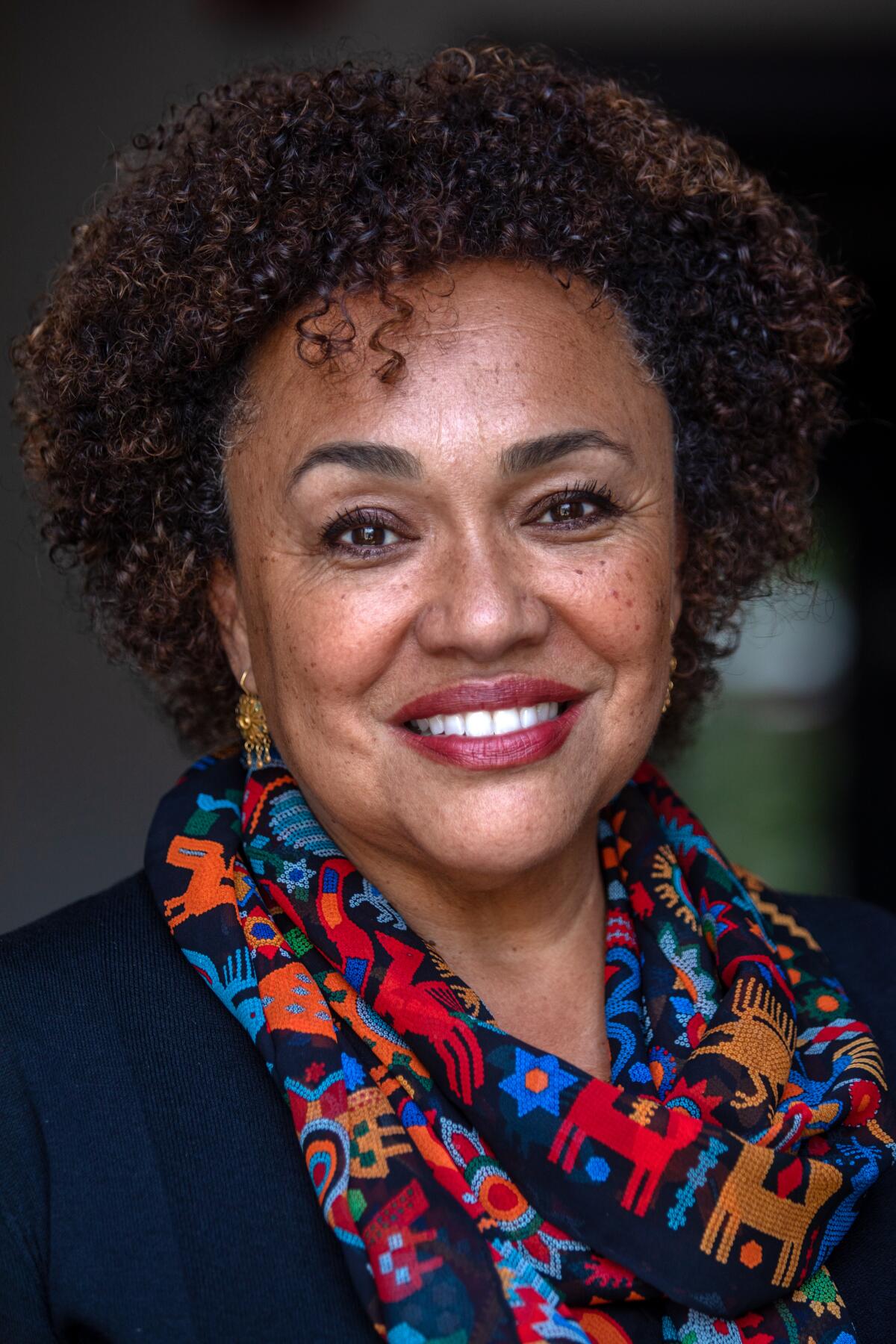
Conservative Beltway pundits might puzzle over why the head of a federal arts agency would drop by a South L.A. community development center instead of, say a symphony hall or an art museum.
But as Jackson sees it, art must serve as more than a source of sublime sensual pleasures. By integrating art into other policy areas — public health, transportation, housing and homelessness, the environment, veterans affairs, community development — Jackson believes we’ll be better able to solve complex problems, create “healthy communities where all people could thrive” and encourage all Americans to lead what she calls vidas artísticas, artful lives.
“I think we’re emerging from a time when we’ve had to adjust our lifestyles, to reimagine work, reconsider what it means to care for each other as a nation,” Jackson said during her keynote address at the USC Center on Philanthropy & Public Policy’s Speakers Series, in a hotel dining hall filled with L.A. power players.
It’s a tall bureaucratic order, even for a woman with Jackson’s formidable résumé and contact network, especially in an era when COVID has scared audiences away from live performance and many creatives struggle to survive, let alone thrive.
But her idea that culture can be a teammate, not merely a colorful sidekick, in White House policy-making fits the priorities of Biden, who issued an executive order in September 2022 that all executive departments, federal agencies and White House policy councils should look for ways to partner with the NEA, the National Endowment for the Humanities and the Institute of Museum and Library Services. That same executive order revived the President’s Committee on the Arts and the Humanities, which had been shut down after its members resigned en masse to protest then-President Trump’s equivocation over the neo-Nazi demonstrations that erupted in Charlottesville, Va., in August 2017.
Jackson notes that Biden has described artists as “truth tellers, bridge builders and change seekers.”
“I can’t imagine an area of policy or practice that can’t benefit from an infusion of that,” she said.
‘Zoot Suit’ is by far the most influential play by a Chicano writer, and the only one to reach Broadway. It changed Los Angeles’ historical memory and the American theater forever
Jackson’s ideals suffused the L.A. community where she was raised. On weekends, her family would attend Catholic Mass, then visit her nearby grandparents. Other times, they’d cruise the museums in Exposition Park or hang out in the Mid-City Black artist enclave of St. Elmo Village.
Later, Jackson learned about African American artists like Elizabeth Catlett, who developed a profound connection to Mexican art, lived in Mexico for 60 years and told Ebony magazine in 1970, “I am inspired by Black people and Mexican people, my two peoples” — an identity that Jackson shares.
She’s fond of describing her father, a Postal Service worker, and her mother, a bilingual education specialist in the L.A. Unified School District, as “lifelong tourists” in their adopted city.
“So there was this really wonderful curiosity about the city,” Jackson said. “And there was trepidation too, because certainly with my father’s experience coming out of Jim Crow, he was conscious that we were different. And there were places where maybe we didn’t belong.”
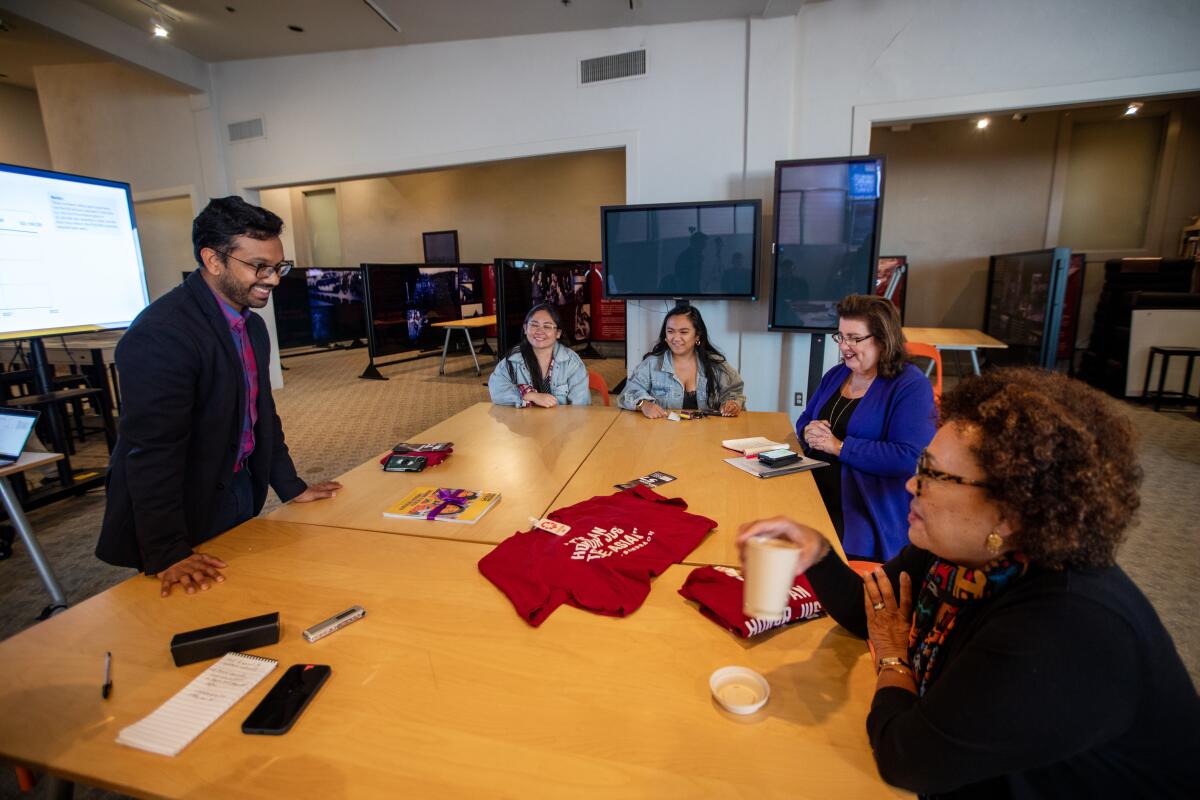
Colleagues and collaborators say Jackson brings that same inquisitive spirit to her work with the NEA, overseeing an independent agency of the U.S. government funded by Congress, with a budget this year of $207 million and a staff of 168. Her personal heritage has helped the NEA’s stepped-up efforts at engaging Latino-serving arts organizations.
The NEA is known primarily as a dispenser of peer-reviewed grants to nonprofit arts organizations, public arts agencies, colleges and universities, federally recognized tribal communities and individual writers and translators. That primary function will continue, Jackson pledges. But she also maintains that NEA shouldn’t be a synonym for “ATM.”
“We have grant money,” she said, “but we also have other currencies, other capacities, that we can make available. The ability to convene. The ability to seed national conversations — in this particular time, hopefully, the creation of environments where we can harvest some of the lessons of the last few years, as we imagine what the next version of the sector needs to look like.”
Despite the brass-knuckled atmosphere in contemporary Washington, Jackson’s NEA thus far has steered clear of the cultural smackdowns that marred the late 1980s and ’90s, when Sen. Jesse Helms (R-N.C.)railed against avant-garde provocateurs like Tim Miller and John Fleck, the two SoCal-based members of the so-called NEA Four, who along with Karen Finley and Holly Hughes sued the agency after it withdrew their fellowships under pressure from Capitol Hill conservatives.
What Jackson can’t tune out is the ticking clock of her tenure. When she meets with a Biden Cabinet member, the first thing she tells them is, “We don’t have much time. There is a window of opportunity that we need to seize.”
Her perpetual equanimity belies this sense of pragmatic urgency. Although she’s fond of saying that “art process can be as important as, or in some cases even more important than, art product,” she’s aware that budget-scrutinizing politicians and dollar-stretching arts administrators may care more about data-driven results than soul-nurturing quests.
“I think what she’s trying to do may or may not be achievable, which is to develop a zone in which the role of arts and culture in the work of the other agencies is so clearly compelling and vital that it becomes almost self-evident that that’s the way we ought to work,” Rapson said. “I think we’re seeing that a little bit as a society at the local level. It’s hard to imagine now high-functioning local communities without vibrant, interconnected local cultural scenes, in all of the complexity of the ecology: big institutions and medium-size institutions and grassroots institutions. But I don’t think that is as self-apparent to federal agencies.”
Anna Deavere Smith revisits ‘Twilight: Los Angeles, 1992’
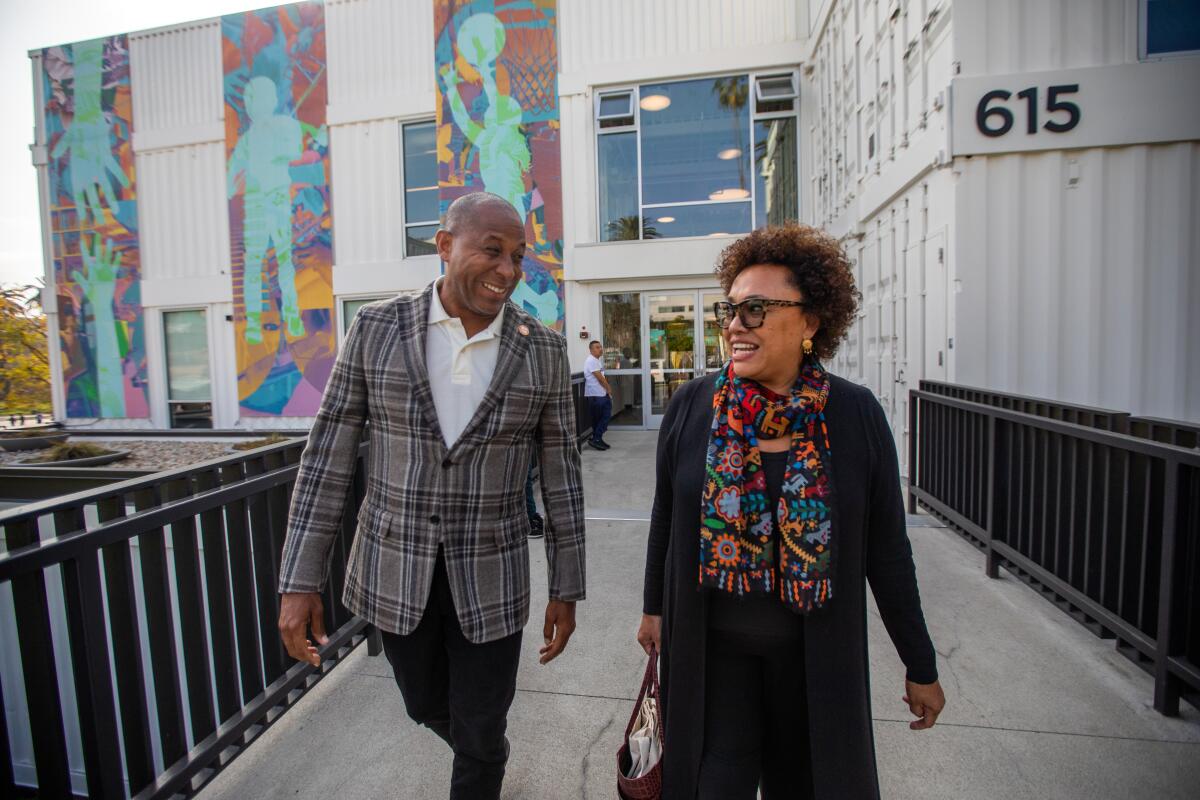
Jackson knows what can happen when good policy gets stuck on the drawing board while society slumbers.
On April 29, 1992, when the L.A. uprising broke out in the wake of four LAPD officers being acquitted in the beating of Black motorist Rodney King, she was at City Hall interviewing a bureaucrat for her PhD dissertation. He told Jackson that she’d better head home because the trial verdict was about to be delivered, and “it’s about to jump off” in the streets of L.A.
“So I went home,” Jackson recalled, “and things jumped off.”
The title of her thesis?
“‘Comprehensive Community Development In the Multi-Ethnic Inner City,’” Jackson replied, managing a smile.
A few weeks shy of the uprising’s 31st anniversary last year, on another drizzly spring day, Jackson agrees to meet at Simply Wholesome, the much-loved Googie-style, Afro-centric Slauson Avenue emporium that survived the ’92 uprising largely because it was Black-owned. It’s a hive of community-focused entrepreneurship and neighborhood pride. Stevie Wonder shows up and jams there sometimes.
“People go and congregate and chat and chew and dream up stuff,” Jackson said, sipping a pineapple ginger tonic and munching a Jamaican patty.
Jackson grew up 10 minutes away from Simply Wholesome and still lives nearby. Her elementary school, St. John the Evangelist, and St. Mary’s Academy in Inglewood, the all-girls Catholic high school she attended, also are about 10 minutes away.
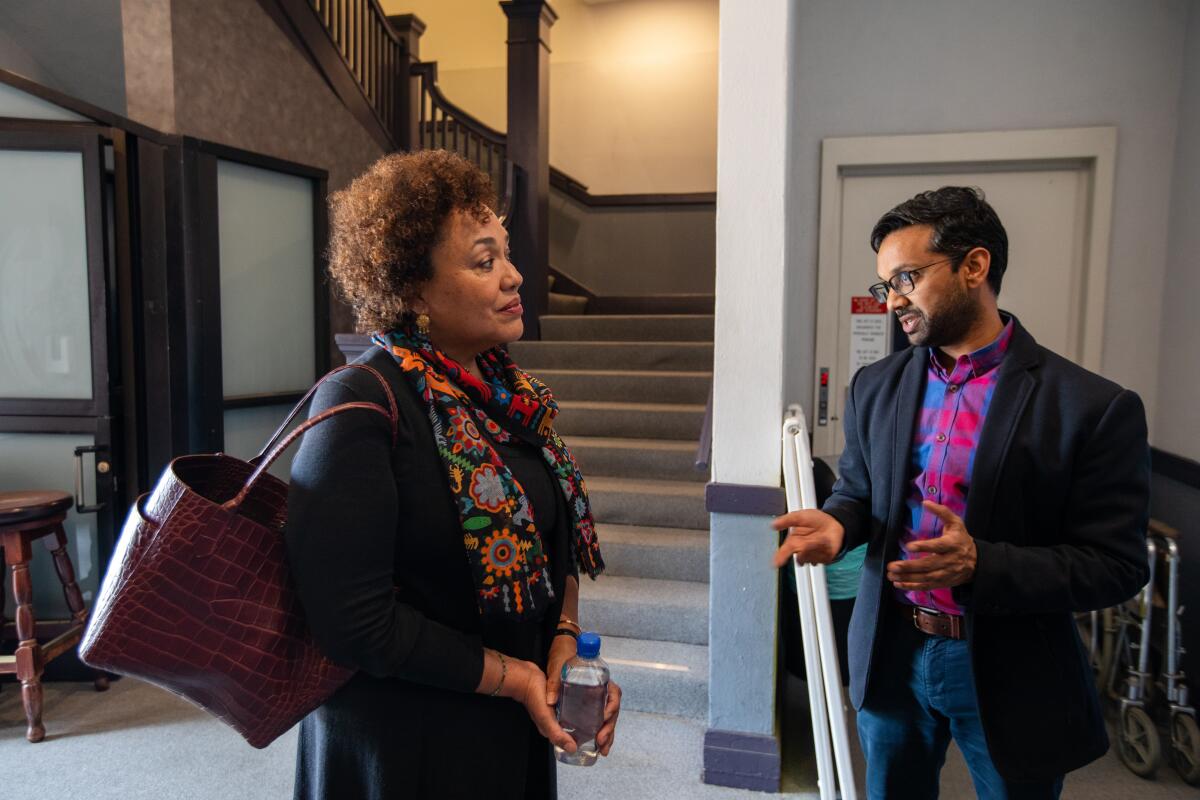
One of the most artistically gifted people Jackson ever knew was her older brother, who worked for LAUSD and died of congestive heart failure in 2014.
“He was very smart, very talented. Had some mental health issues,” Jackson said. “Could play piano by ear, could hear something and play it. Also, he had a beautiful voice — booming, beautiful voice. He liked many different kinds of music. Practicing opera sometimes. He had a fascination with Enrico Caruso.”
Does the nation’s premier culture advocate feel she’s living the kind of “artful life” she champions?
“I think so. I try to,” she said. She has “dabbled” in ceramics since high school, “but that takes time. It’s a commitment. I wish I had more time for that.”
Jackson paused.
“I think this idea of artful lives shows up in my life,” she said, “whether it’s making a home or creating special experiences when friends or family are over — that kind of thing. Trying to be a steward of some traditions that are particularly meaningful. That’s part of an artful life.”
Once again, she turned the conversation to the NEA.
“We’re responsible for bringing something that I think is so essential to having meaningful lives. It’s tending to your humanity. That’s important stuff.”
Outside, the rain was easing up. Another long day stretched ahead for the woman trying to help an uneasy country slow down long enough to listen and look together.
More to Read
The biggest entertainment stories
Get our big stories about Hollywood, film, television, music, arts, culture and more right in your inbox as soon as they publish.
You may occasionally receive promotional content from the Los Angeles Times.
